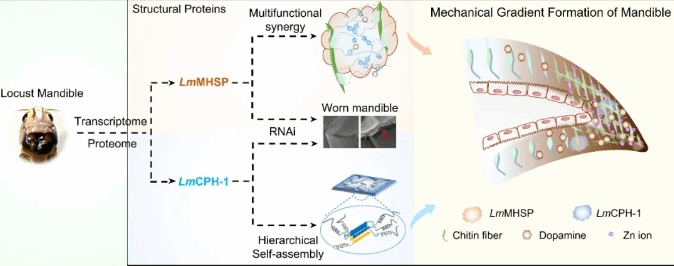Date:Mar 27, 2024
In a remarkable showcase of scientific collaboration and innovation, the biomolecular target research laboratory has published two high-level papers in quick succession. The research, spearheaded by Professor Liu Tian’s team from the School of Bioengineering, in partnership with Professor Yang Qing’s team from the Chinese Academy of Agricultural Sciences, signifies major progress in their joint project.

The teams' groundbreaking findings were featured in two prestigious international journals. The first paper, titled "A core structural protein that builds the locust mandible with a mechanical gradient," was published in ACS Nano, a renowned journal with an impact factor (IF) of 17.1 and recognized in the Nature Index. The second paper, "Major structural protein in locust mandible capable of forming extraordinarily stiff materials via hierarchical self-assembly," found its platform in Matter, the sibling publication of the influential Cell journal, boasting an impressive impact factor of 18.9.
These studies delve into the intricate architecture and incredible robustness of the locust's mandible structure. Professor Liu Tian's team and Professor Yang Qing's team have jointly decoded the secrets behind the mechanical gradient of the locust mandible, attributing it to a core structural protein that allows the insect to adapt and thrive in various environments.
Their work does not just unveil the marvels of natural design but also opens up potential avenues for the development of advanced biomimetic materials. By understanding how these proteins contribute to the locust’s mandible strength through tiered self-assembly processes, researchers can now envision creating new materials that replicate such durability and toughness.
The publication of these papers is a testament to the dynamic research environment fostered within Chinese institutions and their successful collaborations with other esteemed entities. The ability to publish in journals of such high impact reflects the thoroughness and innovation of the research